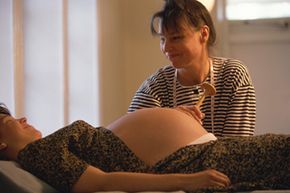Types of Midwives
If you're looking to employ a midwife for childbirth, it's important to note that there are several different types in the U.S. These midwives differ on how they received their training. Certified nurse-midwives (CNMs) are registered nurses who possess a bachelor's degree (and more commonly, a master's degree) and who have received an additional one to two years of midwife training. CNMs are certified by the American College of Nurse-Midwives (ACNM) and tend to work in hospitals or stand-alone birthing centers. While CNMs are typically retained for childbirth, they can provide a range of well-woman care, from pap smears and contraceptive counseling to menopause relief. CNMs can practice in every state in the U.S.
Certified midwives aren't nurses, but they do receive their certification from the ACNM, just as CNMs do. They must have a bachelor's degree and attend training from an ACNM-accredited program. Currently, certified midwives can only practice in a handful of states. Direct-entry midwives may also only practice in a handful of states. These midwives may learn their craft through self-study, apprenticeship or in a school setting. They may or may not have a college degree, and they tend to practice in people's homes or in birthing centers.
Advertisement
You may encounter midwives who claim to be certified professional midwives. This is a credential bestowed by the North American Registry of Midwives, and the certification is based on a written exam and hands-on skills evaluations. The idea behind this certification is that it doesn't matter where you learn how to deliver a baby, so long as you know how to do it safely. Direct-entry midwives and certified nurse-midwives may both apply for this qualification.
While there are several types of midwives, there's really only one kind of patient that's appropriate for this type of care, and that's a woman who's having a low-risk pregnancy. That said, the great majority of pregnancies in the U.S. are low-risk. A low-risk pregnancy involves a young mother (generally no older than 35) in good health, with an absence of factors like gestational diabetes, prior difficult births, twins or triplets, or hypertension. Women who don't fit the profile are usually encouraged to see a doctor. For low-risk pregnancies, though, midwives say they can provide a more supportive and compassionate environment for natural birth.
Midwives are trained to recognize signs of trouble in a birth, and some midwives have formed partnerships with obstetricians who will serve as their backup should an emergency occur. Midwives can't perform surgeries, so if an emergency C-section is necessary, so will a doctor. Certified nurse-midwives, because of their hospital backgrounds, are more likely to have these partnerships, whereas direct-entry midwives, who might practice in private homes, are viewed with more suspicion. On the next page, we'll consider the controversial subject of home birth.
